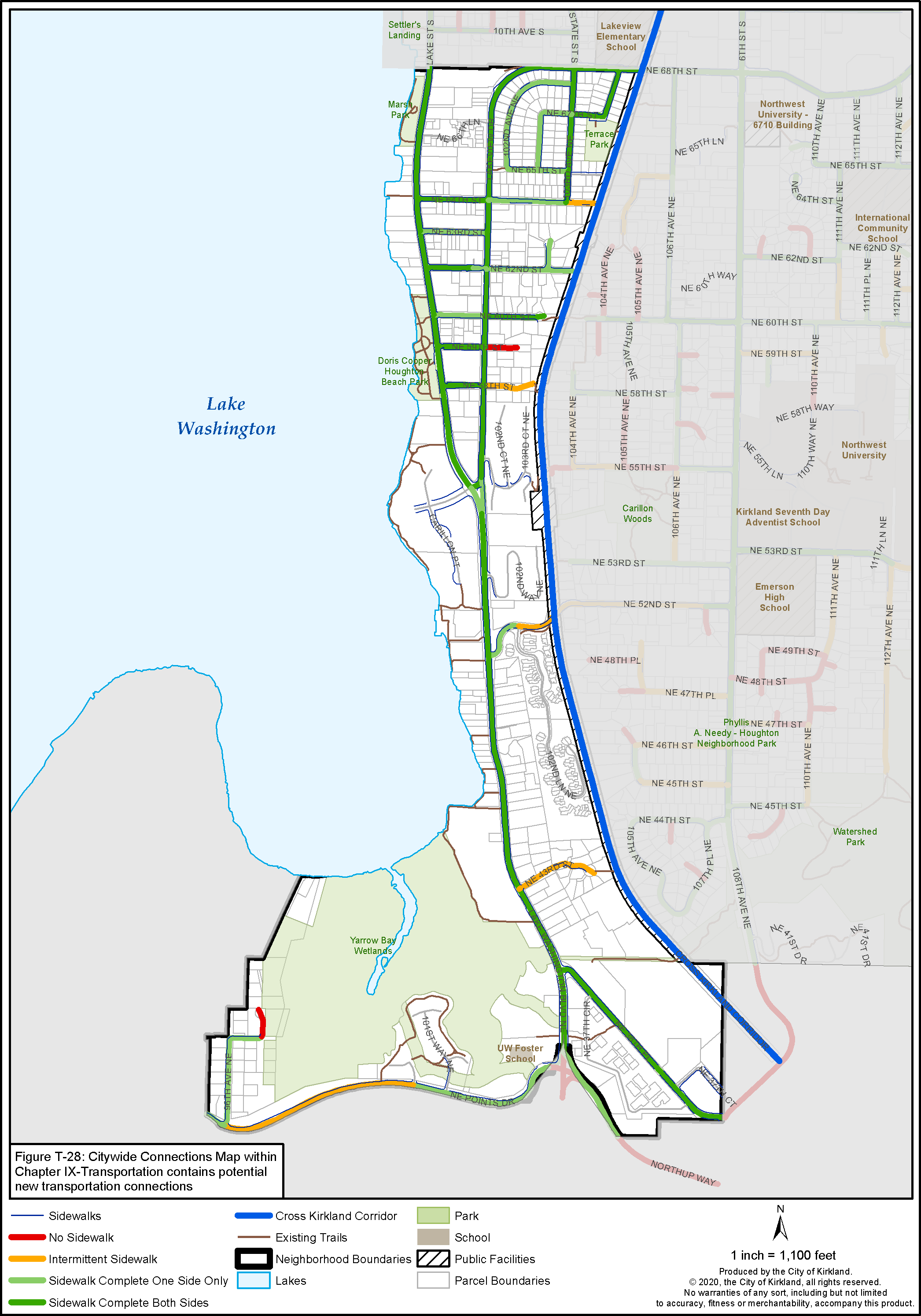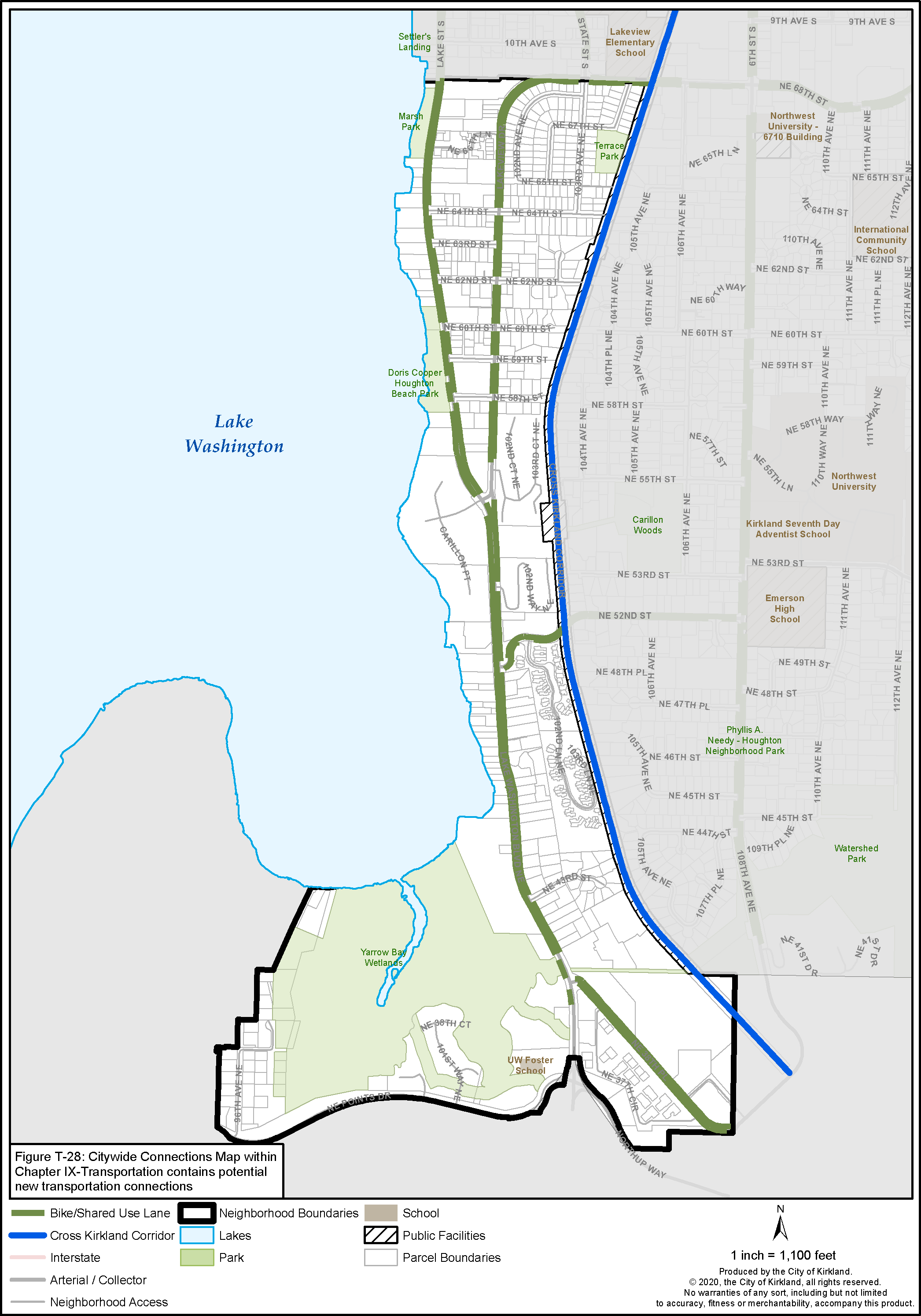6. Transportation
The circulation patterns in the Lakeview Neighborhood are well established and permit through traffic to flow north and south on both Lakeview Drive and Lake Washington Boulevard. Northup Way, NE 52nd Street and NE 68th Street provide the east-west connections to the Central Houghton neighborhood.
Goal L-10: Improve vehicle, pedestrian and bicycle mobility along Lake Washington Boulevard NE.
Lake Washington Boulevard is designated as a principal arterial and provides the major north-south route through Kirkland south of the Central Business District and west of I-405 (See Figure L-4). The Boulevard also provides local access for a substantial number of residential developments and businesses. A significant proportion of existing traffic, however, is probably attracted to the Boulevard as much because of the scenic vistas of Lake Washington and ease of convenience or necessity. The scenic qualities of the Boulevard also contribute to making it a major pedestrian and bicycle corridor, serving waterfront park users, joggers, strollers, and Downtown shoppers.
Traffic on Lake Washington Boulevard has greatly increased, particularly during morning and evening commute periods. This congestion restricts local access to and from the Boulevard and has created noise, safety problems, and conflicts for pedestrians, bicyclists, and adjacent residents.
Policy L-10.1: Enhance Lake Washington Boulevard NE as a scenic, recreational, open space and transportation corridor.
Improvements to the Boulevard could help accommodate its broader amenity function in such a manner that the safety of all the Boulevard’s diverse users is enhanced, while significant amounts of through traffic are not diverted to other arterials. Accordingly, a master plan or set standards for Lake Washington Boulevard should be established through a public process that considers the following objectives:
1. Strategies to relieve congestion during commute times to improve traffic flow and provide gaps in traffic to improve access from adjacent properties.
2. Widen sidewalks to improve pedestrian circulation on both sides of the street with the widest sidewalks on the west side.
3. Improve pedestrian crossings at intersections and adjacent to waterfront parks where safety considerations allow such installation. One option that could be studied is the concept of providing a pedestrian bridge across Lake Washington Boulevard in the Yarrow Bay Business District to facilitate pedestrian crossing and provide a gateway feature to the City.
4. Use of landscaped median islands to separate traffic and provide pedestrian safety where center left-turn lanes or on-street parking are not needed.
5. Widening bicycle lanes.
6. Installation of on-street parking in areas of high parking demand; provided, that traffic safety will not be impaired.
7. Installation of streetscape amenities such as public art, pedestrian lighting, street furniture, and low level landscaping that will not obscure views of the Lake and will enhance the pedestrian experience along the street.
Figure L-4: Lakeview Street Classifications
Policy L-10.2: Implementation of the above street improvements should be considered through the City’s Capital Improvement Program process and site specific with private redevelopment.
The means for implementing these improvements should be both on a comprehensive area-wide basis and, to the extent possible, on an incremental basis by encouraging or requiring them to be incorporated into private development.
Policy L-10.3: Support regional transportation solutions that will reduce commuter or pass through traffic through the neighborhood and along Lake Washington Boulevard NE.
Also important to the successful achievement of greater amenity and mobility functions for Lake Washington Boulevard will be traffic improvements that are regional in scope. Accordingly, the City should support and encourage the following regional solutions:
1. Alternatives to the single-occupancy vehicle for commuting purposes, such as increased use of Metro Transit, commuter pool, high-occupancy vehicles (HOV), and the investigation of future modes, such as light rail.
2. Improvements to the I-405/SR 520 corridors.
Policy L-10.4: Maintain Lakeview Drive as a minor arterial and alternative route to Lake Washington Boulevard NE through the neighborhood.
Lakeview Drive is designated as a minor arterial and fully developed with two through lanes, bicycle lanes, sidewalks, and street trees. From its intersection with Lake Washington Boulevard, Lakeview Drive provides the primary route to the Houghton Business District and to State Street, which in turn provides access to the Central Business District. Lakeview Drive/ State Street provide an alternative north-south vehicular route from Lake Washington Boulevard during peak commute times. Future traffic levels should be monitored and necessary measures undertaken to mitigate impacts.
Policy L-10.5: Improve pedestrian and bicycle circulation systems as both recreation amenities and as nonmotorized transportation connections to neighborhood as well as City and regional destinations.
The path/trail system shown in Figures L-5 and L-6 indicates the major elements of the pedestrian and bicycle circulation network in the neighborhood. Pedestrian and bicycle pathways provide a recreation as well as transportation function. Potential new connections are shown in Figure T-28 within Chapter IX, Transportation. The following pedestrian and bicycle connections should be priorities within the neighborhood:
1. From Lake Washington Boulevard east to the future Cross Kirkland Corridor on the railroad right-of-way and the Central Houghton Neighborhood.
2. Between properties in the Yarrow Bay Business District and to the South Kirkland Park and Ride and future transit-oriented development.
3. Along the Lake Washington shoreline with connections to Lake Washington Boulevard as required by the shoreline regulations. Existing signs marking the location of public shoreline pedestrian walkways should be maintained by private development.
4. From Yarrow Bay Wetlands to Watershed Park.
5. Along NE 60th Street trail from Houghton Beach Park east through the City to connect to the regional trail at Marymoor Park in Redmond.
6. From SR 520, and Bellevue to the South.
These trails will cross a combination of City parklands, City rights-of-way, and public access easements. The trails should be part of the City’s Active Transportation Plan and implemented through the Capital Improvement Program or private development. The trails will improve neighborhood access and enhance the unique areas they traverse.
Figure L-5: Lakeview Neighborhood Pedestrian System
Figure L-6: Lakeview Bicycle System
Policy L-10.6: Support development of a future Cross Kirkland Corridor as multipurpose trail.
Development of the old BNSF railroad right-of-way as a multipurpose corridor for bikes, pedestrians and potentially for rail transit should be designed to:
• Result in a public benefit to the citizens of Kirkland.
• Serve as a gateway to the City.
• Provide neighborhood connections.
• Be compatible in scale with adjacent neighborhoods.
• Ensure a high degree of safety.
• Show environmental stewardship.





